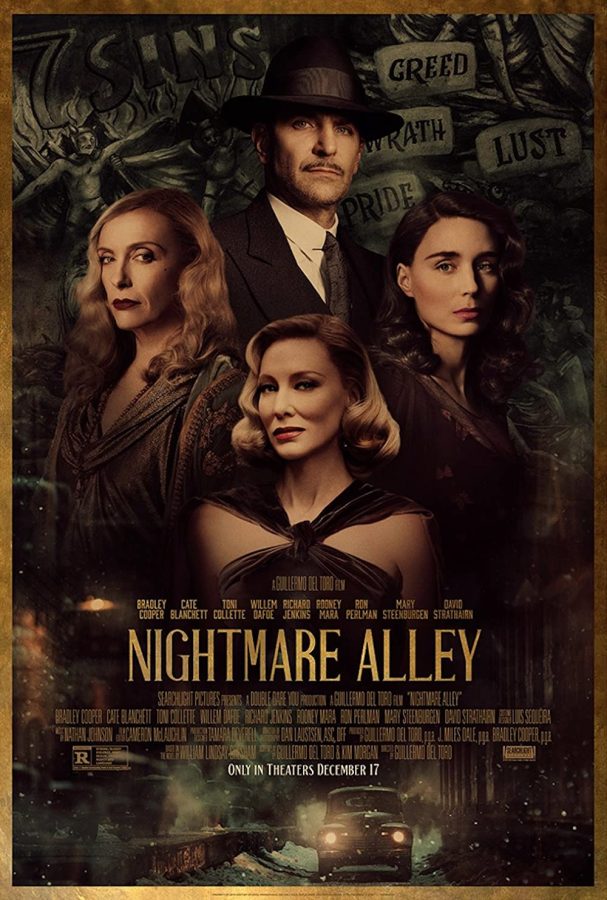“Nightmare Alley” review: A dark carnival ride in GDT’s hands
March 13, 2022
Guillermo del Toro is one of modern cinema’s most original voices, so his approach to remaking the 1947 noir classic “Nightmare Alley” looms with particular fascination. Nominated for Best Picture at the 94th Academy Awards, the film brims with del Toro’s sumptuously dark visual machinations.
The unique production design of “Nightmare Alley” recently led to its Best Period Feature award at this year’s Art Directors Guild Awards. The last time a del Toro film won the same accolade (2018’s “The Shape of Water”), it went on to win Academy Awards for production design as well as Best Picture. Viewers have long recognized the Mexican director’s masterfully macabre aesthetics, also showcased in 2006’s “Pan’s Labyrinth” and “Crimson Peak” (2015) as well as two “Hellboy” films.
What’s more interesting, perhaps, with regard to “Nightmare Alley” is assessing del Toro’s touch with the namiest cast he’s ever assembled, including the A-list likes of Bradley Cooper, Cate Blanchett, Rooney Mara, Toni Colette, and Willem Dafoe to name only a few. A few questions arise: Does the production suffer under the crushing all-star weight of its talented roster of performers? Are the individual performances unified under del Toro’s singularly signature macabre vision, or does the film deserve the criticism which has also been leveled (not entirely fairly, in my view) against Ridley Scott’s “House of Gucci” that maybe all these superstars are doing their own thing in their own movie?
Cooper, whose work has truly found its stride since 2018’s “A Star is Born,” leads the way as protagonist Stanton Carlisle. Like most del Toro leads, Carlisle is on the run from the demons (in this case, of his Depression-era past). It’s a neat trick to see Cooper and del Toro fully embrace Stan’s twisted psychology to an even greater extent than the original, which opted to tack on a more hopeful ending than we’re afforded here.
A grifter from the get, Stan wanders into a traveling carnival looking for an angle. He finds it in Madame Zeena (Colette), whom he connects with on both intellectual and physical levels, and her alcoholic husband, Pete (David Strathairn). Initially enlisted as a mere laborer and custodian of the resident, live chicken-eating “geek” by carnival manager Clem (Dafoe), Stan soon becomes fascinated by Zeena and Pete’s mentalism act and dives headlong into learning how the two go about convincing unsuspecting audience members that they can speak to the dead.
Along the way, Stan grows infatuated with fellow performer Molly (Mara), whose body is seemingly impervious to electric current. As Stan watches Molly’s body writhe on stage as lightning-like current courses through her, Cooper dazzles, revealing the slightest crack in Stan’s seemingly impenetrable armor. For a moment at least, del Toro gives us hope for his troubled protagonist. It will prove fleeting.
Stan, of course, spirits Molly away from the carnival to the big city and to fame as a mentalist in his own right. He meets Dr. Lilith Ritter (the ever-magnetic Blanchett), who will ultimately manage to outgrift Stan by making him an offer he can’t refuse. The second half of the film loses a bit of steam when Blanchett’s not around, as Stan attempts to swindle the wealthy Ezra Grindle (Richard Jenkins) into thinking he can communicate with Grindle’s dead lover.
As Stan’s world unravels, Cooper’s performance effectively shifts from measured to manic and Blanchett’s cold, cunning response is devastating. Mara’s role is surely a supporting one, but the actress plays vulnerability with such grace that the tragedy of her character falling prey to vultures like Stan and Lilith makes an even more profound impact. The entire cast seems at home in del Toro’s dark carnival and, especially amidst the always glorious backdrop of the director’s cinematography and production design, they make “Nightmare Alley” a ride worth taking.
Click here to stream “Nightmare Alley” on HBO Max.








